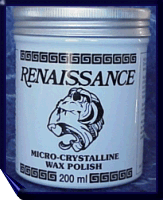

The Balisong Collector's Bookmarks Essential Products for Knife Collectors
 "By appointment to Her Majesty The Queen of England, Supplier
of Products for Restoration and Conservation." Renaissance
wax was originally developed by the British Museum and is now
used by the virtually every major museum in the world to protect
valuable furniture, leather, paintings, metals, marble, ivory,
and many other surfaces." A knife collector is, in a way,
the curator and conservator of his own museum. Steel rusts, brass
tarnishes, wood dries, leather decays... it's enough to drive
a collector mad. It only makes sense to use the same product used
by professionals: renaissance wax. It a bit expensive, yes. But
a little bit goes a long way (the 65ml jar for $12 + s&h will
easily protect 100 balisongs). Ren wax is quite durable. The treated
knife can be handled, and, if the knife isn't handled aggressively,
the treatment will protect the knife for years.
"By appointment to Her Majesty The Queen of England, Supplier
of Products for Restoration and Conservation." Renaissance
wax was originally developed by the British Museum and is now
used by the virtually every major museum in the world to protect
valuable furniture, leather, paintings, metals, marble, ivory,
and many other surfaces." A knife collector is, in a way,
the curator and conservator of his own museum. Steel rusts, brass
tarnishes, wood dries, leather decays... it's enough to drive
a collector mad. It only makes sense to use the same product used
by professionals: renaissance wax. It a bit expensive, yes. But
a little bit goes a long way (the 65ml jar for $12 + s&h will
easily protect 100 balisongs). Ren wax is quite durable. The treated
knife can be handled, and, if the knife isn't handled aggressively,
the treatment will protect the knife for years.
My ren wax tip: try not to wax just one knife at a time. Line up eight or ten. The first one takes a lot more wax since you have to get the cloth wet. Once you get going, every fifth or sixth knife will be free, i.e. you won't need any wax out of the jar.
You'll find lots of other uses for this stuff around the house. If, for example, you own real silver silverware, you know that you have to polish it several times per year even if you don't use it. The solution is to ren wax it and you won't need to polish again for years. Ren Wax is wonderful on anything brass or silver.
![]() Flitz
Metal Polish is a non-abrasive polish suitable for all metals.
Being non-abrasive, it's my preferred polish. It can remove tarnish,
rust, water stains, oxidation, and hardened fingerprints with
remarkably little effort. While Flitz is safe on metals, it can
damage some insert materials, so use it carefully.
Flitz
Metal Polish is a non-abrasive polish suitable for all metals.
Being non-abrasive, it's my preferred polish. It can remove tarnish,
rust, water stains, oxidation, and hardened fingerprints with
remarkably little effort. While Flitz is safe on metals, it can
damage some insert materials, so use it carefully.
Keep in mind that not all knives should be polished. Polishing can actually destroy the collectible value of an older knife. Many older carbon-steel blades have a wonderful blue/gray patina. That oxide layer not only speaks of age, but it is the metal's natural protection from rust. Old brass gets a wonderful deep gold color. A bit of Flitz can make these surfaces shine like new... but that would NOT be a good thing to do. Many older blades, those found on Filipino Handmade balisongs, for example, were not originally polished since the makers didn't have the equipment and supplies to polish them. With Flitz, you can polish them brightly. But, again, that would NOT be a good thing to do.
It is very difficult to get Flitz out of the grain of wood or out of leather, so don't get it on wood or leather in the first place. It's also hard to get Flitz out of cracks other tight places on a knife including inside the joints of a balisong. So be very careful not to get it in there in the first place. I often use a cotton swab (Q-Tip(tm)) to apply Flitz. So, while Flitz is gentle and non-abrasive, it's still something you have to use with great forethought and great care.
My Flitz tip: Flitz is a chemical polish, not an abrasive polish; you don't need to rub. Apply it with just enough rubbing to work it into the surface irregularities. Let it sit for a minute or so. And then buff it off with a soft cloth.
This is another product that's kind of expensive. But, it's another product where a little bit will go a long way. The 50 gram tube for $8.99 + s&h will easily polish a hundred balisongs. But, this is also another product that, once you've got it around the house, you will find a hundred other uses for.
 This company offers a very nice assortment
of display and storage stands and cases for all sorts of things
including knives.
This company offers a very nice assortment
of display and storage stands and cases for all sorts of things
including knives.
My USAdisplay tip: I worry about long-term storage in plastic cases. Plastics out gas. That means they release chemical gasses. This is why the windows of your car get that sort of dull film on the inside, especially for the first year or so in a new car. It's all the plastics and foams out gassing. That same film can dull the surfaces of your knives. So, I recommend against using plastic boxes or cases for long-term storage. They're great for shows, though. And check out USAdisplay's selection of wood and glass cases.
 If you really want an impressive way to show off your knives,
Tomway is THE way. Tomway's wonderful display cases are handmade
of beautiful Cocobolo rosewood. Tomway offers a wide selection
of boxes and cases to hold one knife or a whole collection.
If you really want an impressive way to show off your knives,
Tomway is THE way. Tomway's wonderful display cases are handmade
of beautiful Cocobolo rosewood. Tomway offers a wide selection
of boxes and cases to hold one knife or a whole collection.
My Tomway tip: you need to be very careful about the knives you select to put into your Tomway case. If you're not, the case may easily end up being more beautiful than the knives.
 "My
knives are covered under my homeowners insurance." That's
what many collectors think. It's usually a mistake. While you
may have, say, $100,000 coverage for "contents," most
policies have specific sub-limits for specific categories of property.
"Collectibles," is often one of those categories. It's
not unusual for a common homeowner's or renter's policy with $100,000
in contents coverage to have a collectibles limit of just $2000.
It's not hard to get up to $2000 with just a handful of knives.
And keep in mind that the "collectibles" category includes
everything you own that has special value due to rarity, historical
interest, or artistic merit.
"My
knives are covered under my homeowners insurance." That's
what many collectors think. It's usually a mistake. While you
may have, say, $100,000 coverage for "contents," most
policies have specific sub-limits for specific categories of property.
"Collectibles," is often one of those categories. It's
not unusual for a common homeowner's or renter's policy with $100,000
in contents coverage to have a collectibles limit of just $2000.
It's not hard to get up to $2000 with just a handful of knives.
And keep in mind that the "collectibles" category includes
everything you own that has special value due to rarity, historical
interest, or artistic merit.
By the way, many knife collectors also have an interest in guns. Firearms are another special category on most homeowner's and renter's insurance policies. Firearms are common theft targets. Furthermore, because there's a ready black market for them, firearms are commonly involved in insurance fraud. (Sell the guns on the black market, claim 'em as stolen, and you can make a double profit.) As a result, the sub-limit on firearms is often quite low. $500 is not uncommon. Couple that with the $250 deductible that's common on homeowner's and renter's insurance and despite the fact you are paying for $100,000 in contents insurance, you end up with almost no insurance on your firearms; that's what the insurance company wants.
You can buy a "rider" on your homeowner's or renter's insurance to increase that limit. If you have a valuable knife collection, you should explore that option. But you'll probably find that the rates are high and/or they require a detailed inventory and/or professional appraisals at your expense.
Collectibles Insurance Agency specializes in property insurance for collectors. In fact, knives and firearms are their special specialty.
My Collectibles Insurance Agency tip: When you travel by air domestically in the US, your ticket includes $2500 worth of insurance for your checked baggage. That's not per-bag, that's total. A nice pair of shoes can be worth $100. A good suit is easily $500. It's not hard to reach that limit with just your ordinary things much less a nice knife or two. And with airport security the way it is these days, you MUST put ALL of your knives into your CHECKED baggage. Most airlines sell "excess valuation insurance." But they don't promote it, so very often the clerks don't even know how to sell it to you. And it's expensive. Delta airlines, for example, will sell you $5000 coverage per bag, but it costs $50 per bag. If you're only checking one bag, then you just spent $50 to purchase $2500 worth of insurance (the first $2500 are included with your ticket purchase) that will only, assuming they don't mis-route your bag, be in effect for a matterof hours. $5000 worth of insurance from CIA is $22 per year. My point is that if you travel with even a few knives even a few times per year, maybe go to a couple of shows, you can pay for your CIA premium just in the savings of not buying the airline's excess valuation insurance. And yes, CIA's insurance specifically includes checked airline baggage.
CIA is underwritten by Hartford Insurance Group.